Research - (2021) Volume 9, Issue 5
Correlation of Secondary Hyperparathyroidism with Chronic Kidney Disease and its Stages
N Deepthi, E Dhandapani and Radhakrishnan A*
*Correspondence: Radhakrishnan A, Department of General Medicine, Sree Balaji Medical College & Hospital Affiliated to Bharath Institute of Higher Education and Research, India, Email:
Abstract
To study the prevalence of secondary hyperparathyroidism in chronic kidney disease. To measure serum intact parathormone levels in chronic kidney disease patients aged more than 20 years, attending SBMCH, Chennai. To associate increased parathormone levels with the different stages of chronic kidney disease in these patients. In this study, the results are statistically significant indicating that there is enough evidence to suggest that patients with CKD stage IV and V are at 8.6 times higher risk of having increased serum iPTH levels and the prevalence of secondary hyperparathyroidism increased as the stage of CKD increases. Serum iPTH is a worthwhile tool in assessing secondary hyperparathyroidism in patients with CKD.
Keywords
Hyperparathyroidism, Kidney disease, Albuminuria, Hypertension.
Introduction
Chronic Kidney Disease is a clinical syndrome characterized by irreversible renal dysfunction leading to excretory, metabolic, and systemic failure as a result of accumulation of nitrogenous waste products & presenting with a myriad of clinical features with decreased creatinine clearance [1-3]. In spite of various etiologies, CKD is the final common pathway of the irreversible destruction of nephrons, ultimately resulting in "alteration of milieu interior" affecting every system in the body [4].
CKD leads to various complications. Secondary Hyperparathyroidism is an important complication of CKD. But it remains underrecognized and under-diagnosed at earlier stages of CKD. There is paucity of Indian studies, regarding the prevalence of secondary hyperparathyroidism in Indian CKD in its various stages. Thus, this study was conducted to study the association and prevalence of secondary hyperparathyroidism in CKD and its stages [5,6].
Materials and Methods
Setting
The study was conducted among patients attending Sree Balaji Medical College & Hospital, Bharath University, Chrompet, Chennai.
Study design
Single Center Cross sectional study
Study period
Our study was conducted between June 2016 and June 2017 for a period of 1Year.
Study population
A total of 60 patients aged more than 20 years, either attending OPD or admitted in Sree Balaji Medical College and Hospital, were included in the study after they were screened using the exclusion and inclusion criteria.
Inclusion criteria
Patients with CKD aged > 20 years, in varying stages of severity.
Exclusion criteria
✓ Patients with Acute Kidney Injury (AKI).
✓ Patients with primary hyperparathyroidism.
Criteria for chronic kidney disease
Presence of objective kidney damage for at least three months. Kidney damage being defined as pathologic abnormalities or markers of damage including abnormalities in blood or urine tests or imaging studies. Imaging study is usually an ultra-sonogram abdomen showing:
✓ Bilateral contracted kidneys OR
✓ Poor corticomedullary differentiation OR
✓ Renal parenchymal changes OR
✓ Glomerular filtration rate (GFR) less than 60ml/min/1.73m2 for at least three months with or without kidney damage.
Glomerular filtration rate
The estimated glomerular filtration rate, was calculated using CKD-EPI equation:
GFR=141 × min (SCr/κ, 1) α × max (SCr/κ, 1)– 1.209 ×0.993Age
Multiply by 1.018 for women.
Multiply by 1.159 for African ancestry.
where SCr is serum creatinine in mg/dL, κ is 0.7 for females and 0.9 for males, α is –0.329 for females and – 0.411 for males, min indicates the minimum of SCr/κ or 1, and max indicates the maximum of SCr/κ or 1.
Classification of CKD
The National Kidney Foundation has classified chronic kidney disease into five stages based on GFR.
✓ Stage I with GFR > or=90 ml/min/1.73m2.
✓ Stage II with GFR between 60 -89 ml/ min/1.73m2.
✓ Stage III with GFR between 30 -59 ml/ min/1.73m2.
✓ Stage III a – 30 – 44 ml/min/1.73m2.
✓ Stage III b – 45 – 59 ml/min/1.73m2.
✓ Stage IV with GFR between 15 -29 ml/ min/1.73m2, and
✓ Stage V with GFR <15 ml/min/1.73m 2.
✓ A recently updated classification, in which stages of CKD are stratified by both estimated GFR and the degree of albuminuria, to predict risk of progression of CKD. However, for the convenience of this study, we have grouped stages I, II and III together since they are mild renal failure, whereas Stage IV and V together since they are moderate to severe renal failure, even requiring dialysis.
Description of the study
Detailed clinical history was taken from all the patients who were included in the study. History of hypertension, diabetes mellitus, any drug intake was taken.
All the patients were examined clinically in detail. The following investigation were done by collecting blood samples and ultrasonogram of abdomen was done.
List of investigations to be done:
✓ Serum urea and creatinine.
✓ Estimated glomerular filtration rate.
✓ USG abdomen.
✓ Serum calcium.
✓ Serum phosphorus.
✓ Intact parathormone (iPTH) level.
Criteria for secondary hyperparathyroidism
The criteria for diagnosis of secondary hyperparathyroidism are a low-normal calcium, high phosphate and elevated parathyroid hormone levels.
Results
Gender distribution
In our study, 51.67% of the study group were men i.e., 31 male patients with the remainder 29 being female patients (48.3% of the study population) (Table 1). In our study population, the minimum age observed was 28 years and maximum age was 87 years, with the mean 59.27. Majority of the patients were in the age group between 41 and 60 years, 28 patients (46.67% of study population) were in this group. The next common age group was age more than 60 years, 27 patients (45% of the study population) were in this group. 8.3% of the study population were in the age group of 20 to 40 years (Figure 1). In this study,55 % of the study population (n=33) had diabetes mellitus. Out of the 33 patients with diabetes mellitus, 57.7% (n=19) were male and 42.4% (n=14) were female patients (Table 2 and Figure 2).
| Gender | Frequency | Percent |
|---|---|---|
| Male | 31 | 51.67 |
| Female | 29 | 48.33 |
| Total | 60 | 100 |
Table 1: Distribution of patients according to their gender.
| Diabetes Mellitus | Frequency | Percent |
|---|---|---|
| Yes | 33 | 55 |
| No | 27 | 45 |
| Total | 60 | 100 |
Table 2: Patients with diabetes mellitus.
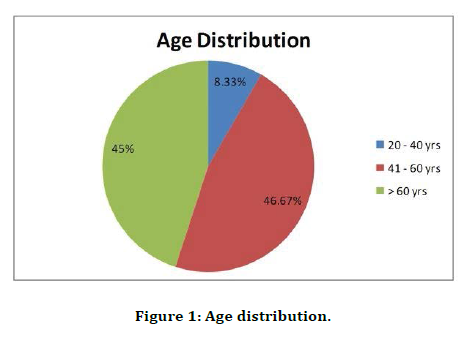
Figure 1. Age distribution.
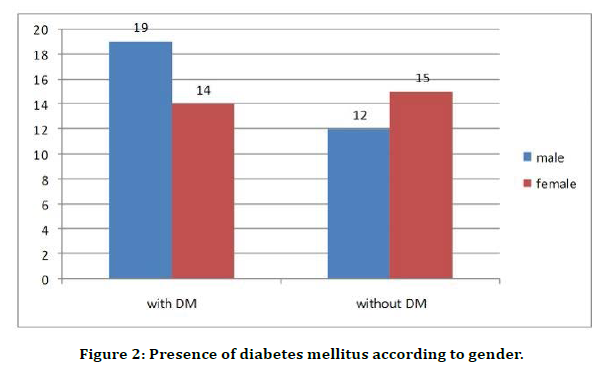
Figure 2. Presence of diabetes mellitus according to gender.
In this study, 75 % of the study population (n=45) had hypertension. Out of the 45 patients with hypertension, 55.6% (n=25) were male and 44. 4% (n =20) were female patients (Figure 3 and Figure 4).
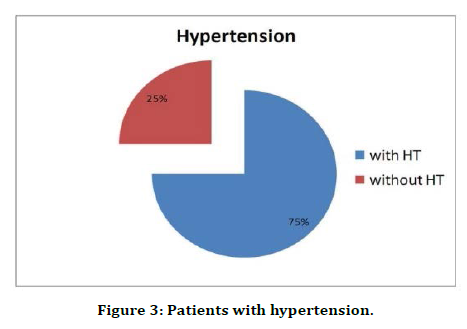
Figure 3. Patients with hypertension.
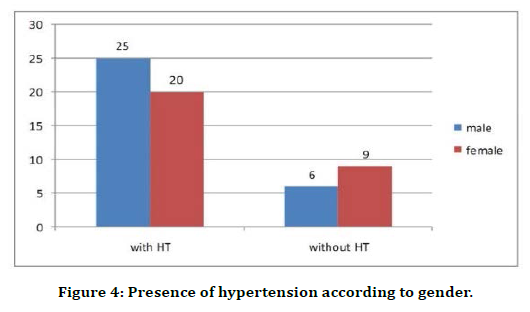
Figure 4. Presence of hypertension according to gender.
In the study group, the mean blood urea level measurement was 58.53 mg/dl. Majority of the patients, 71.67% (n=43) of study population had blood urea levels ranging from 41 to 80 mg/dl (Figure 5).
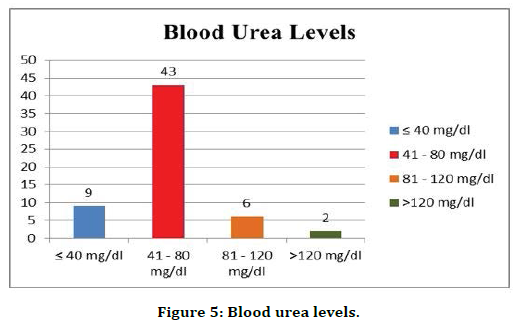
Figure 5. Blood urea levels.
In the study group, the mean serum creatinine level measurement was 3.29 mg/dl. Majority of the patients, 75% (n=45) of study population had serum creatinine levels ranging from 1.3 to 5mg/dl (Table 3). In the stud population, the mean estimated glomerular filtration rate was 27.1 (Table 4).
| Serum creatinine levels | N | % |
|---|---|---|
| ≤ 1.2 mg/dl | 4 | 6.67 |
| 1.3-5.0 mg/dl | 45 | 75 |
| > 5.0 mg/dl | 11 | 18.33 |
| Total | 60 | 100 |
Table 3: Serum creatinine levels.
| N | Minimum | Maximum | Mean | Std. Deviation | |
|---|---|---|---|---|---|
| EGFR | 60 | 6 | 78 | 27.1 | 17.86835 |
Table 4: Estimated glomerular filtration rate.
Ultrasound abdomen showed evidence of CKD in all the 60 patients. Bilaterally contracted kidneys were present in 33(55% of study population) patients. Remaining 27 patients (45% of study population) had poor cortico-medullary differentiation (Table 5 and Figure 6).
| USG abdomen | Frequency | Percent |
|---|---|---|
| Bilateral Contracted Kidneys | 33 | 55 |
| Corticomedullary differentiation lost | 27 | 45 |
| Total | 60 | 100 |
Table 5: Ultrasonogram abdomen.
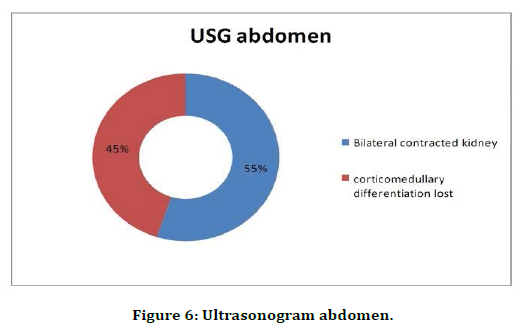
Figure 6. Ultrasonogram abdomen.
In our study of CKD patients, 14% of male patients and 40% of female patients in stage III, 20% of male patients and 25% of female patients in Stage IV, and 18% of male patients and 41.6 % of female patients in stage V had secondary hyperparathyroidism (Table 6). For convenience, stage IV, V were grouped together and stage I, II, III were grouped together based on severity. In our study, 25 out of 36 patients in stage IV and V (69.4%) had increased parathormone levels and 5 out of 24 patients in stages I, II, III (20.8%) had elevated parathormone levels. Patients with CKD stage IV and V are at 8.6 times higher risk of having increased serum iPTH levels. The association between serum iPTH and different stages of CKD is statistically significant (p<0.05) (Table 7).
| Stage of CKD | Total no of male patients | Male | Total no of female patients | Female | ||||||
|---|---|---|---|---|---|---|---|---|---|---|
| With SHPT | Without SHPT | With SHPT | Without SHPT | |||||||
| N | % | N | % | N | % | N | % | |||
| Stage I | 3 | 0 | 0 | 3 | 100 | 1 | 0 | 0 | 1 | 100 |
| Stage II | 5 | 0 | 0 | 5 | 100 | 3 | 0 | 0 | 3 | 100 |
| Stage III | 7 | 1 | 14 | 6 | 85.7 | 5 | 2 | 40 | 3 | 60 |
| Stage IV | 5 | 1 | 20 | 4 | 80 | 8 | 2 | 25 | 6 | 75 |
| Stage V | 11 | 2 | 18 | 9 | 81.8 | 12 | 5 | 41.6 | 7 | 58.33 |
| Total | 31 | 4 | 27 | 29 | 9 | 20 | ||||
Table 6: SHPT according to gender distribution.
| CKD stage | Total | Pts with increased iPTH | Percent | OR [95%cl] | Chi- square Test | p value |
|---|---|---|---|---|---|---|
| Stage IV, V | 36 | 25 | 69.4 | 8.636 | 13.611 | 0.00022 |
| Stage I, II, III | 24 | 5 | 20.8 |
Table 7: Patients with elevated sr. iPTH in various stages.
Discussion
In our study, 51.67% of the study group were men i.e., 31 male patients with the remainder 29 being female patients (48.3% of the study population). In our study population, the minimum age observed was 28 years and maximum age was 87 years, with the mean 59.27. Majority of the patients were in the age group between 41 and 60 years, 28 patients (46.67% of study population) were in this group. The next common age group was age more than 60 years, 27 patients (45% of the study population) were in this group. 8.3% of the study population were in the age group of 20 to 40 years. In this study, 55 % of the study population (n=33) had diabetes mellitus [7]. Out of the 33 patients with diabetes mellitus, 57.7% (n=19) were male and 42. 4% (n=14) were female patients.75 % of the study population (n=45) had hypertension. Out of the 45 patients with hypertension, 55.6% (n=25) were male and 44.4% (n =20) were female patients.
In the study group, the mean blood urea level measurement was 58.53 mg/dl. Majority of the patients, 71.67% (n=43) of study population had blood urea levels ranging from 41 to 80 mg/dl. In the study group, the mean serum creatinine level measurement was 3.29 mg/dl. Majority of the patients, 75% (n=45) of study population had serum creatinine levels ranging from 1.3 to 5mg/dl. In the study population, the mean estimated glomerular filtration rate was 27.1. Ultrasound abdomen showed evidence of CKD in all the 60 patients. Bilaterally contracted kidneys were present in 33(55% of study population) patients. Remaining 27 patients (45% of study population) had poor cortico- medullary differentiation [8-11].
In the study, 38.3 % (n=23) of study population were in stage V, 21.7 %(n=13) were in stage IV, 20 % (n= 12) were in stage III, 13.3% (n=8) were in stage II, 6.7% (n=4) were in stage I. In the study group, the mean serum calcium level measurement was 8.45 mg/dl. Majority of the patients, 61.67% (n=37) of study population had serum calcium levels ranging from 8.1 to 11 mg/dl. For convenience, stage IV, V were grouped together and stage I, II, III were grouped together based on severity. In our study, 25 out of 36 patients in stage IV and V (69.4%) had increased parathormone levels and 5 out of 24 patients in stages I, II, III (20.8%) had elevated parathormone levels [12-14]. Patients with CKD stage IV and V are at 8.6 times higher risk of having increased serum iPTH levels. The association between serum iPTH and different stages of CKD is statistically significant (p<0.05).
Conclusion
In this study, the results are statistically significant indicating that there is enough evidence to suggest that patients with CKD stage IV and V are at 8.6 times higher risk of having increased serum iPTH levels and the prevalence of secondary hyperparathyroidism increased as the stage of CKD increases. Serum iPTH is a worthwhile tool in assessing secondary hyperparathyroidism in patients with CKD. Secondary hyperparathyroidism is associated with mortality and morbidity in CKD. It can occur in earlier stages and through simple routine tests of serum iPTH, it can be diagnosed earlier, and appropriate treatment can be instituted, as delayed diagnosis encounters resistant SHPT, which persists even after renal transplantation and acc ounts for cardiovascular mortality and morbidity.
Funding
No funding sources.
Ethical Approval
The study was approved by the Institutional Ethics Committee.
Conflict of Interest
The authors declare no conflict of interest.
Acknowledgments
The encouragement and support from Bharath University, Chennai, is gratefully acknowledged. For provided the laboratory facilities to carry out the research work.
References
- https://bjssjournals.onlinelibrary.wiley.com/doi/abs/10.1002/bjs.1800680325
- Johnson SJ, Sheffield EA, McNicol AM. Best practice no 183: Examination of parathyroid gland specimens. J Clin Pathol 2005; 58:338-342.
- https://books.google.co.in/books?id=REKbRGsyStMC&printsec=copyright&redir_esc=y#v=onepage&q&f=false
- Kayima JK, Otieno LS, Gitau W, et al. Thyroid hormone profiles in patients with chronic renal failure on conservative management and regular haemodialysis. East African Med J 1992; 69:333-336.
- Coetzee M, Kruger MC. Osteoprotegerin-receptor activator of nuclear factor-kappaB ligand ratio: A new approach to osteoporosis treatment?". Southern Med J 2004; 97:506–511.
- Peacock M. Calcium metabolism in health and disease. Clin J Am Society Nephrol 2010; 5:S23-S30.
- Goodman WG. Calcium and phosphorus metabolism in patients who have chronic kidney disease. Med Clin North Am 2005; 89:631 -647.
- Berndt TJ, Schiavi S, Kumar R. “Phosphatonins” and the regulation of phosphorus homeostasis. Am J Physiol Renal Physiol 2005; 289:F1170–F1182.
- Segawa H, Onitsuka A, Kuwahata M, et al. Type IIcsodium dependent phosphate transporter regulates calcium metabolism. J Am Soc Nephrol 2009; 20:104–113.
- Goodman WG. The consequences of uncontrolled secondary hyperparathyroidism and its treatment in chronic kidney disease. Seminars Dialysis 2004; 17:209-216.
- Foley RN. Temporal trends in the burden of chronic kidney disease in the United States. Curr Opin Nephrol Hypertens 2010; 19:273-277.
- Lim VS. Thyroid function in patients with chronic renal failure. Am J Kidney Diseas 2001; 38:S80-S84.
- Rostand SG, Drueke TB. Parathyroid hormone, Vit. D, and cardiovascular disease in chronic renal failure. Kidney Int 1999; 56:383-392.
- Rix M, Andreassen H, Eskildsen P, et al. Bone mineral density and biochemical markers of bone turnover in patients with predialysis chronic renal failure. Kidney Int 1999; 56:1084-1093.
Author Info
N Deepthi, E Dhandapani and Radhakrishnan A*
Department of General Medicine, Sree Balaji Medical College & Hospital Affiliated to Bharath Institute of Higher Education and Research, Chennai, Tamil Nadu, IndiaCitation: N Deepthi, E Dhandapani, Radhakrishnan A, Correlation of Secondary Hyperparathyroidism with Chronic Kidney Disease and its Stages, J Res Med Dent Sci, 2021, 9 (5):298-303.
Received: 22-Mar-2021 Accepted: 24-May-2021
